محاضرة 5 فيزياء عامة (1) ميكانيكا نيوتن .. الحركة في بعدين
درسنا في المحاضرة السابقة الحركة في بعد واحد أي عندما يتحرك الجسم في خط مستقيم على محور x أو أن يسقط الجسم سقوطاً حراً في محور y، سندرس في هذه المحاضرة حركة جسم في بعدين أي في كل من x,y مثل حركة المقذوفات حيث يكون للإزاحة والسرعة مركبتان في اتجاه المحور x والمحور y. وتعتبر حركة المقذوفات Projectile motion من الأمثلة على الحركة في بعدين، وسوف نقوم بإيجاد معادلات الحركة للمقذوفات لتحديد الإزاحة الأفقية والرأسية والسرعة والعجلة من خلال العديد من الأمثلة.
Motion in two dimensions
Motion in two dimensions like the motion of projectiles and satellites and the motion of charged particles in electric fields. Here we shall treat the motion in plane with constant acceleration and uniform circular motion.
درسنا في الفصل السابق الحركة في بعد واحد أي عندما يتحرك الجسم في خط مستقيم على محور x أو أن يسقط الجسم سقوطاً حراً في محور y، سندرس الآن حركة جسم في بعدين أي في كل من x,y مثل حركة المقذوفات حيث يكون للإزاحة والسرعة مركبتان في اتجاه المحور x والمحور y.
Motion in two dimension with constant acceleration
Assume that the magnitude and direction of the acceleration remain unchanged during the motion.
The position vector for a particle moving in two dimensions (xy plane) can be written as
![]()
where x, y, and r change with time as the particle moves
The velocity of the particle is given by

Since the acceleration is constant then we can substitute
vx = vxo + axt vy = vyo + ayt
this give
v = (vxo + axt)i + (vyo + ayt)j
= (vxo i + vyo j) + (ax i + ayj) t
then
v = vo + a t (***)
من المعادلة (***) نستنتج أن سرعة جسم عند زمن محدد t يساوى الجمع الاتجاهى للسرعة الابتدائية والسرعة الناتجة من العجلة المنتظمة.
Since our particle moves in two dimension x and y with constant acceleration then
x = xo + vxo t + 1/2 ax t 2 & y = yo + vyo t – 1/2 ay t 2
but
r = xi + yj
r = (xo + vxo t + 1/2 a t 2)i + (yo + vyo t – 1/2 g t 2)j
= (xo i + yo j) + (vxoi+ vyoj)t +1/2 (axi+ ayj)t 2
r = ro + vot + 1/2 a t 2 (###)
من المعادلة (###) نستنتج أن متجه الإزاحة r–ro هو عبارة عن الجمع الإتجاهى لمتجه الإزاحة الناتج عن السرعة الابتدائية vot والإزاحة الناتجة عن العجلة المنتظمة .1/2 a t 2.
Projectile motion
تعتبر حركة المقذوفات Projectile motion من الأمثلة على الحركة في بعدين، وسوف نقوم بإيجاد معادلات الحركة للمقذوفات لتحديد الإزاحة الأفقية والرأسية والسرعة والعجلة من خلال العديد من الأمثلة.
Example
A good example of the motion in two dimension it the motion of projectile. To analyze this motion lets assume that at time t=0 the projectile start at the point xo=yo=0 with initial velocity vo which makes an angle qo, as shown in Figure 2.5.
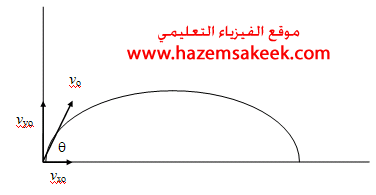
then
vx = vxo = vocosqo = constant
vy = vyo – gt = vosinq o – gt
x = vxo t = (vocosqo)t
y = vyo t – 1/ g t2 = (vosinq o)t – 1/2 g t2
Horizontal range and maximum height of a projectile
It is very important to work out the range (R) and the maximum height (h) of the projectile motion.
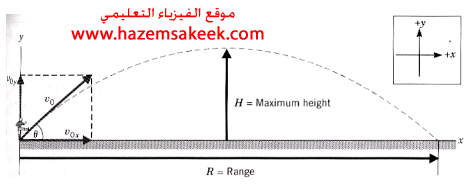
To find the maximum height h we use the fact that at the maximum height the vertical velocity vy=0
by substituting in equation
vy = vosinq o – gt 
To find the maximum height h we use the equation
y = (vosinq o)t – 1/2 g t 2
by substituting for the time t1 in the above equation
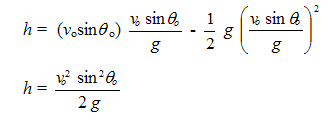
من المعادلة (الأخيرة)نلاحظ أقصى ارتفاع يصل إليه الجسم المتحرك في بعدين كحركة المقذوفات على عجلة الجاذبية، وعليه فإن المقذوفات على سطح القمر تأخذ مساراً ذا مدى وارتفاع أكبر منه على سطح الأرض كما في الشكل أدناه.

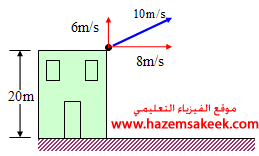 Example
Example
Suppose that in the example above the object had been thrown upward at an angle of 37o to the horizontal with a velocity of 10m/s. Where would it land?
Solution
Consider the vertical motion
voy = 6 m/s
ay = -9.8m/s2
y = 20m
To find the time of flight we can use
y = vyo t – 1/2 g t 2
since we take the top of the building is the origin the we substitute for
y = -20m
-20 = 6 t – 1/2 9.8 t 2
t = 2.73s
Consider the horizontal motion
vx = vxo = 8m/s
then the value of x is given by
x = vx t = 22m
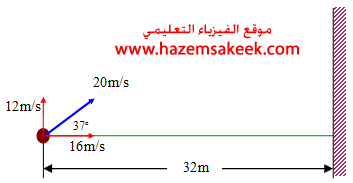 Example
Example
In the Figure shown below where will the ball hit the wall
Solution
vx = vxo = 16m/s
x = 32m
Then the time of flight is given by
x =vt
t =2s
To find the vertical height after 2s we use the relation
y = vyo t – 1/2 g t 2
Where vyo = 12m/s, t =2s
y = 4.4m
Since y is positive value, therefore the ball hit the wall at 4.4m from the ground
To determine whether the ball is going up of down we estimate the velocity and from its direction we can know
vy = vyo – gt
vy = -7.6m/s
Since the final velocity is negative then the ball must be going down.

